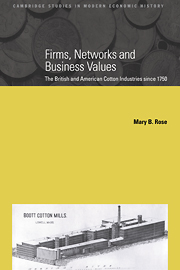Book contents
- Frontmatter
- Contents
- List of figures
- List of tables
- Acknowledgements
- 1 Introduction: the evolution of two industries
- Part I The culture of business networks 1750–1860
- 2 Industrialisation and the cotton industry in Britain and the United States
- 3 Family firms, networks and institutions to 1860
- 4 The management of labour to 1860
- 5 Networks and the evolution of government–industry relations to 1860
- Part II Continuity and change
- References
- Index
- Cambridge Studies in Modern Economic History
4 - The management of labour to 1860
Published online by Cambridge University Press: 12 September 2009
- Frontmatter
- Contents
- List of figures
- List of tables
- Acknowledgements
- 1 Introduction: the evolution of two industries
- Part I The culture of business networks 1750–1860
- 2 Industrialisation and the cotton industry in Britain and the United States
- 3 Family firms, networks and institutions to 1860
- 4 The management of labour to 1860
- 5 Networks and the evolution of government–industry relations to 1860
- Part II Continuity and change
- References
- Index
- Cambridge Studies in Modern Economic History
Summary
Differences in the relative supply of labour, land, power and raw cotton differentiated the American from the British cotton industry and contributed to contrasting patterns of costs, technological development, productivity performance and business organisation. Before 1840 American cotton masters, in general, were faced with less plentiful and less elastic supplies of labour than their counterparts in Britain. Yet there were, nevertheless, sharp contrasts in the labour markets faced by the water-powered Lowell corporations in the 1820s and 1830s and those in urban centres such as Philadelphia, quite apart from the peculiarities of labour markets in the Southern states. Equally in Britain, although the factory system evolved against a background of relative labour surplus, there were imperfections in regional labour markets, especially where water power was used. Inevitably, therefore, in early industrialisation there emerged an array of labour and related technological strategies tailored to meet local, as opposed to purely national, conditions.
Disparities in the evolution of business institutions, of technology and of product strategies cannot be understood exclusively in terms of differing price relativities. Similarly, national and regional dissimilarities in the development of labour management also need to be set in a wider context. The cultures and capabilities of family firms in the cotton industries of Britain and the United States were inseparable from their community cultures during the eighteenth and nineteenth centuries and this symbiosis extended to the management of labour. Thus networks that underpinned financial and commercial arrangements, on either side of the Atlantic, were also a feature of labour relations, the arrangement of work and of training.
- Type
- Chapter
- Information
- Firms, Networks and Business ValuesThe British and American Cotton Industries since 1750, pp. 99 - 132Publisher: Cambridge University PressPrint publication year: 2000

